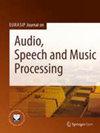声学对象消除:使用盲同步从单声记录中去除已知信号
IF 1.9
3区 计算机科学
引用次数: 0
摘要
摘要在本文中,我们提出了一种从单声录音中去除特定类型干扰的技术。非平稳干扰通常很难从这样的记录中消除。但是,如果干扰是已知的声音,如手机铃声、CD或流媒体服务中的音乐、广播或电视广播,则很容易获得其源信号。在我们的方法中,我们将这种干扰定义为声学对象。即使录音和声学对象的采样频率不匹配,我们也会对不匹配进行补偿,并使用最大似然估计技术和辅助函数来消除录音中的干扰。我们比较了几种表示对象取消信号的概率模型。实验验证了该方法的有效性。本文章由计算机程序翻译,如有差异,请以英文原文为准。
Acoustic object canceller: removing a known signal from monaural recording using blind synchronization
Abstract In this paper, we propose a technique for removing a specific type of interference from a monaural recording. Nonstationary interferences are generally challenging to eliminate from such recordings. However, if the interference is a known sound like a cell phone ringtone, music from a CD or streaming service, or a radio or TV broadcast, its source signal can be easily obtained. In our method, we define such interference as an acoustic object. Even if the sampling frequencies of the recording and the acoustic object do not match, we compensate for the mismatch and use the maximum likelihood estimation technique with the auxiliary function to remove the interference from the recording. We compare several probabilistic models for representing the object-canceled signal. Experimental evaluations confirm the effectiveness of our proposed method.
求助全文
通过发布文献求助,成功后即可免费获取论文全文。
去求助
来源期刊

Journal on Audio Speech and Music Processing
Engineering-Electrical and Electronic Engineering
CiteScore
4.10
自引率
4.20%
发文量
28
期刊介绍:
The aim of “EURASIP Journal on Audio, Speech, and Music Processing” is to bring together researchers, scientists and engineers working on the theory and applications of the processing of various audio signals, with a specific focus on speech and music. EURASIP Journal on Audio, Speech, and Music Processing will be an interdisciplinary journal for the dissemination of all basic and applied aspects of speech communication and audio processes.
 求助内容:
求助内容: 应助结果提醒方式:
应助结果提醒方式:


